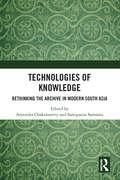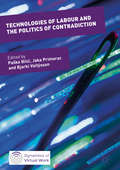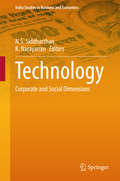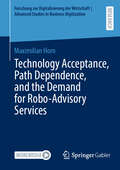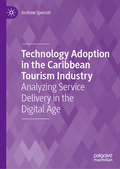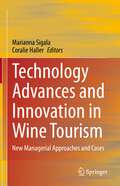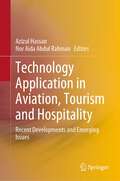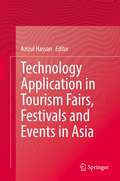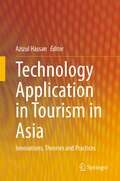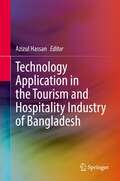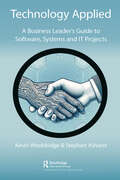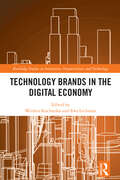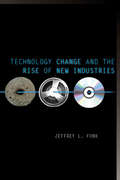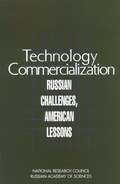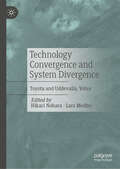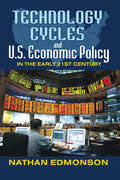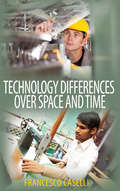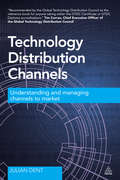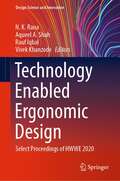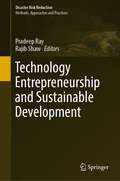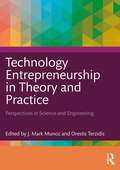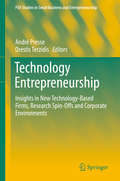- Table View
- List View
Technologies of Knowledge: Rethinking the Archive in Modern South Asia
by Samiparna Samanta Aryendra ChakravarttyThis book traces the role of technology in shaping, curating, disseminating, and archiving knowledge and life in South Asia. It focuses on empirical studies of transformative social processes unleashed by technological intervention in colonial and postcolonial contexts, which have changed our everyday lives and created new sites of domination and resistance, and new archives of history.Unraveling technology as an indicator of South Asia’s encounter with modernity, the chapters in the volume interrogate how technology was witnessed in the production of culture, historicizing and preserving the past, and establishing claims to heritage and history. In addition to examining the critical role of creative and commercial networks in establishing communities, the volume also scans the significant contribution of technology as a mechanism of social control. It highlights the pervasive nature of discourse that continues to assert its legitimacy, despite significant challenges to its structures of dominance, be it in the case of Bengali women or imperial dreams of curating a rapidly eroding past. In doing so, the volume emphasizes the discursive thoughts and practices that permeate the functioning of an empire and a postcolonial nation-state through narratives of resilience, appropriation, silences, and dissent.This volume will be of great interest to scholars and researchers of science and technology studies, digital humanities, South Asian studies, modern history, colonialism, and post-independence India.
Technologies of Labour and the Politics of Contradiction (Dynamics Of Virtual Work Ser.)
by Paško Bilić Jaka Primorac Bjarki ValtýssonThis book is situated in the nexus between technology, labour and politics. It focuses on contradictions as heuristic devices that uncover struggles, frictions and ambiguities of digitalization in work and labour environments. Topics include contradictions in automation, internet platforms, digital practices, creative industries, communication industries, human interaction, democratic participation and regulation. Three cross-cutting themes can be identified within the diverse chapters represented in the book. First, many authors argue that labour and economic valorisation occur outside of the traditional concept of working space and time. Second, digital technology is not fixed under capital. It is malleable and mouldable. Third, many political tensions are occurring without organized awareness or dissent. The book will, therefore, be of interest to researchers and students in the fields of sociology of work, media studies, cultural studies, gender studies, science and technology studies and Critical Theory as well as to trade-unionists and policy makers.
Technology
by K. Narayanan N. S. SiddharthanThis volume deals with the role and impact of technology on the economy and society. The papers on corporate dimensions address the impact of patents, determinants of innovative activities, differential behaviour of multinationals, industrial groups and other firms with regard to innovations and technology. In contrast, the papers on social dimensions chiefly deal with the role of technology in reducing inequality. The majority of the papers employ econometric techniques and other statistical methods, and many are based on primary data. The studies emphasise the importance of innovations (especially patents) and human capital in influencing productivity across Indian states, the significance of patenting in determining the efficiency of firms, the role of business groups in promoting innovations, differences in the technological characteristics of multinational and domestic firms, and how mergers and acquisitions can promote R&D. The papers on social dimensions analyse how innovative activities can shape employment, the impact of technology on poverty, the socioeconomic characteristics of mobile phone ownerships, use of information and communications technologies at educational institutions, and the influence of Synchronous Technologies in reducing access to teaching programmes. The studies show that those Indian states that have invested in human capital and technology experienced higher labour productivity. Further, the studies establish a positive correlation between R&D spending and employment. Lastly, they demonstrate that the adoption of agriculture-related technologies can have a significant impact on rural poverty and consumption expenditures.
Technology Acceptance, Path Dependence, and the Demand for Robo-Advisory Services (Forschung zur Digitalisierung der Wirtschaft | Advanced Studies in Business Digitization)
by Maximilian HornThis book explores the effects of the previously ignored factors of path dependence and product features on technology acceptance with a focus on robo-advice. A newly developed model introduces path dependence to technology acceptance research allowing to explain previously unaccountable effects. An empirical test of the model using data from Germany and the USA elicits that path dependence influences the attitudes towards and demand for robo-advice. A process consisting of a market survey, a choice-based conjoint analysis, and a test in a technology acceptance model allows the structured investigation of the effects of product features on the demand for robo-advice. The results show that selected product features have effects on the demand for robo-advice and that it is essential to establish these effects empirically.
Technology Adoption in the Caribbean Tourism Industry: Analyzing Service Delivery in the Digital Age
by Andrew SpencerThis book investigates the adoption of Information and Communication Technologies (ICTs) in Caribbean travel firms, particularly for sales and marketing purposes. By examining the decision-making process in tourism companies deciding whether to become more dependent on digital capabilities and artificial intelligence, this text seeks to understand the role of strategy and resources in technology adoption. Further, the author assesses the role of factors both external (such as culture) and internal (such as leadership) in this strategic process. Economies in the Caribbean are reliant on tourism to bring prosperity to the region, and with the onset of the COVID-19 pandemic, the industry is being forced to transform the way it operates. With implications for those studying organizational behavior as well as strategic and tourism management, this study analyzes rapid change in this pivotal industry.
Technology Advances and Innovation in Wine Tourism: New Managerial Approaches and Cases
by Marianna Sigala Coralie HallerThis book consolidates under one roof the latest research investigating the various technological advances and new managerial approaches driving innovation within wine tourism. Competition in wine tourism intensifies at a global scale, while wine tourism demand continuously evolves, diversifies and becomes more sophisticated. The book highlights that innovation and technology exploitation have become not only a way to differentiate but also a survival necessity for wine tourism operators and wine destinations alike.This book includes cutting edge research about the latest technological developments and advances that revolutionise the wine tourism sector and transform the way wine tourism experiences are designed and delivered. In addition, the book includes case studies and research findings showing how wine tourism operators and destinations can nurture, support and implement innovation at various levels, including the experience, the process, the business model and/or the ecosystem level.
Technology Application in Aviation, Tourism and Hospitality: Recent Developments and Emerging Issues
by Azizul Hassan Nor Aida Abdul RahmanThis book covers multiple areas such as technology and the type of application in aviation, tourism and hospitality with looking at current and future technology application, as well as in a rural tourism perspective. The strength of this book comes from the authors themselves coming from multiple higher institutions in Malaysia and Indonesia as these two countries are the top two countries in Southeast Asia with the world's most popular tourist destinations and for a reason: a tropical climate, rich culture, gorgeous beaches, wonderful food and low prices. This book is also packed with detailed knowledge in the area of air travel, as well as deep understanding on the related theories used as theoretical underpin in performing air travel research. This book provides insightful discussion and very beneficial to the reader. This book is suitable for the following readers: general, students, travelers, academics, tourism consultants, aviation regulators, aviation practitioners and ministries of tourism. Readers are also exposed to recent issues and development pertaining technology application in aviation tourism and hospitality, theoretical discussion related to technology application as well as its application and future research application.
Technology Application in Tourism Fairs, Festivals and Events in Asia
by Azizul HassanIt is an unconditional reality that the tourism industry in Asia is becoming exposed to innovative technologies more than ever before. This book reports the latest research in the application of innovative technology to the tourism industry, covering the perspectives, innovativeness, theories, issues, complexities, opportunities and challenges affecting tourism in Asia. A blend of comprehensive and extensive efforts by the contributors and editors, it is designed especially to cover technology applications in tourism fairs, festivals and events in Asia. The application and practice of technologies in tourism, including the relevant niches of fairs, festivals and events are also covered, with a focus on the importance of technology in tourism. This book highlights, in a comprehensive manner, technologies that are impacting the tourism industry in Asia, as well as the constraints it is facing. It deals with distinct topics, such as tourism promotion, technology-driven sustainable tourism development, social media, accessibility and so on to cover fairs, festivals and events. This book is a significant contribution towards the very limited knowledge in this identified research area, with examples from selected Asian countries. This book is designed to accommodate both qualitative and quantitative research linking theory and practice. This book has a clear focus on outlining the research issues. Each chapter of the book highlights a methodology that was used, with rationale for its use. This book addresses a number of revisions that unify the theme or framework to integrate the chapters.
Technology Application in Tourism in Asia: Innovations, Theories and Practices
by Azizul HassanThis book very specifically focuses on technology application in tourism in Asia. The book contains twenty-seven chapters in four sections (i.e., theories, innovations, practices, and future research directions), based on the intriguing qualities and importance of technology applications in the Asian tourism business. This book, a blend of comprehensive and extensive efforts by the contributors and editor, is designed to extensively cover technology applications in tourism in Asia, including distinct topics such as mobile computing, new product designs, innovative technology usages in tourism promotion, technology-driven sustainable tourism development, location-based apps, mobility, accessibility, the post crisis situation of COVID-19, etc. This book is a significant contribution towards the very limited knowledge of technology applications in tourism, with selected examples of Asian countries. The importance of technology in Asian tourism is rapidly increasing, and has led to a rise in luxury, allowing citizens to enjoy leisure travel over both long and short distances. The rise of low-cost airlines and the region’s growing, affluent middle class have changed the tourism environment dramatically. More tourists are booking their holidays online as a result of technological advancements. Online travel is the most important and well-established aspect of Asia's Internet economy. Considering the ongoing trend of technology applications in the tourism industry in Asia, more research attempts like this book need to be made aiming towards exploring diverse aspects. As tourism is an expanding area, this book can serve as a reading companion for tourism students, policy planners and industry professionals. This book is expected to be appreciated by expatriate researchers and researchers having a keen interest in the Asian tourism industry.
Technology Application in the Tourism and Hospitality Industry of Bangladesh
by Azizul HassanThe tourism and hospitality industry of Bangladesh as a South Asian country has potential. Sustainable development of this industry in this country is on the move. Still, there are some hindrances which appear to be stymieing this industry’s overall development potential. Overcoming such hindrances can be partly enabled by applying digital innovation and introducing more Internet based platforms in the country’s tourism and hospitality industry. The country is believed to have emphasized innovative technology application in this industry, but technology applications in this industry in Bangladesh have so far attracted very few researchers, resulting in insufficient contributions and very limited knowledge.This book, therefore, can make a significant contribution towards the very limited knowledge in this identified research area. On the specific ground of technology application in the tourism and hospitality industry, the book covers concepts and context, the present scenario, product and service offers, and an analysis of the roles of public and private institutions. On related issues, the book also covers social media, networking and connectivity; sustainability practices and climate change effects; tourist experiences; developments; and challenges, suggestions, and future research directions. The book is expected to appeal to general readers, as well as researchers with an interest in technology applications in the tourism and hospitality industry. This book is also an essential read for the relevant policy planners and industry professionals.
Technology Applied: A Business Leader's Guide to Software, Systems and IT Projects
by Stephen Ashurst Kevin WooldridgeTechnology – love it or hate it – is a critical component for nearly every modern business.To the business leader or aspiring business leader, the world of technology may sometimes appear to be confusing and obscure. The language and nuance of software, systems, and IT projects is often a barrier to effective communication between different parts of an enterprise at just the time when it’s most needed – during a technology-enabled project that is seeking to deliver business benefit.This book sets out, in clear non-technical language and with practical real-world examples, the essential background to different aspects of information technology (hardware, software, data, and interfaces); their latest manifestations, such as artificial intelligence and blockchain; and how they all combine into a technology project.Most importantly, this book helps you, the business leader, understand the people behind the technology, appreciate their perspective and their motivations, and to enable you to ask the crucial questions that could transform your engagement to apply technology effectively.
Technology Brands in the Digital Economy (Routledge Studies in Innovation, Organizations and Technology)
by Ewa Lechman Wioleta KucharskaThis edited volume provides deep insight into theoretical and empirical evidence on how digital technologies and high-tech brands are interrelated. It traces the mutual links between these two phenomena, identifies the multidimensionality of interdependencies, and shows the reader how and why new technologies are the driving factors of creation and global dissemination of high-tech brands. In this context, it also refers to various types of economic and social networks that, on the one hand, are the products of digital technologies, while on the other enforce global visibility of high-tech brands. The book contributes to the present state of knowledge, offering the reader broad evidence on how digital technologies impact the process of high-tech brands' nascence and how their growing role and global exposure influence networked economies and societies. It sets out to deliver a bridge between brand management and economical approaches to understanding how digital technologies and high-tech brands are interrelated. This multidisciplinary approach creates a complex compilation of different views and perspectives that sheds new light on the high-tech brands' phenomena of being an input and output of technology-driven economies. Technology Brands in the Digital Economy is written for scholars and researchers from a wide variety of disciplines but especially for those addressing issues of brands and economic development and growth, social development, and the role of technological progress in broadly defined socio-economic progress. It will also be an invaluable source of knowledge for graduate and postgraduate students in a variety of areas such as economic and social development, information and technology, worldwide studies, social policy, and comparative economics.
Technology Change and the Rise of New Industries
by Jeffrey L. FunkTechnology Change and the Rise of New Industries explores why new industries emerge at specific moments in time and in certain countries. Part I shows that technologies which experience "exponential" improvements in cost and performance have a greater chance of becoming new industries. When "low-end" discontinuities incur exponential improvements, they often displace the dominant technologies and become "disruptive" innovations. Part II explores this phenomenon and instances in which discontinuities spawn new industries because they impact higher-level systems. Part III addresses a different set of questions—ones that consider the challenges of new industries for firms and governments. Part IV uses ideas from the previous chapters to analyze the present and future of selected technologies. Based on analyses of many industries, including those with an electronic and clean energy focus, this book challenges the conventional wisdom that performance dramatically rises following the emergence of a new technology, that costs fall due to increases in cumulative production, and that low-end innovations automatically become disruptive ones.
Technology Commercialization: Russian Challenges, American Lessons
by National Research CouncilThis collection of papers—by American and Russian specialists—addresses a variety of legal, regulatory, institutional, and financial issues that can promote or hinder technology commercialization. The book is the result of a series of workshops organized by the National Research Council with the Russian Academy of Sciences on commercialization of technologies, particularly those developed at research and educational institutions.Technology Commercialization concludes with a list of actions, programs, and policies which warrant further consideration as Russia tries to improve the success of technology commercialization. This book will be of interest to those concerned with small-business development in post-communist states, university technology management, and comparative technology commercialization.
Technology Convergence and System Divergence: Toyota and Uddevalla, Volvo
by Hikari Nohara Lars MedboThis book compares the production systems of Toyota, which has a belt conveyer, and Volvo’s factory in Uddevalla, Sweden, which doesn’t. Uddevalla has been famous as a human-centric work environment since the 1980s, but Toyota’s production style- lean production seems increasingly advantageous. Unlike what lean production is usually considered to imply, the authors finds many shared aspects of both systems, such as the meaningful assembly sequence, assembly-oriented parts grouping, kits for material supplies, buffer mechanisms, and the application of cognitive science. However, in their totality, the different production systems have different impacts on people and society. The differences come from different ways of judging human potential. In this regard, Uddevalla and Toyota can be productively contrasted, identifying the comparative advantages of automation and human labor.
Technology Cycles and U.S. Economic Policy in the Early 21st Century
by Nathan EdmonsonThe overarching theme of this volume is the cyclical nature of technological change, its impact on economic growth, and the limits of government intervention. Technological revolutions are infrequent; there were only three in all of the twentieth century. When they occur, their possibilities are often not immediately apparent. Technology revolutions induce capital investment, not just because they stimulate the need to acquire the new technology, but also because of the need to replace obsolete capacity and new infrastructure. While government has encouraged general economic progress by carrying out highly risky innovations unrelated to fostering economic growth, it seldom succeeds with specific efforts to foster growth. Recent examples of success include the Internet and the global positioning system (GPS), which trace their origins to defense-related research. In contrast, the countercyclical economic stimuli of 2007-2009 have achieved little in the way of general growth. The lack of data about the technology cycle makes formulating appropriate monetary and other policy countercyclical interventions difficult. A technology-founded upswing animated the American economy after 1990, and the -great recession- of 2007- 2009 reflected the waning of the investment boom that this revolution generated. Edmonson argues that the impact of technology revolutions on general economic growth has never received the attention it deserves. This volume will contribute much to debates on economic policy.
Technology Development Assistance for Agriculture: Putting research into use in low income countries (Routledge Explorations in Development Studies)
by Andrew Ward Norman Clark Andy Frost Ian MaudlinStemming from an 11-year DFID funded programme under its Renewable Natural Resources Research Strategy (RNRRS), Technology Development Assistance for Agriculture: Putting Research into Low Income Countries reviews part of this programme as a case study of a broader issue of technology development for Africa. Controversially, it critiques current international technology development assistance and focuses on the potential role of the private sector in agricultural technology development as well as providing insights for future cognate science policy and practice. The book focuses on the RIU "Best Bets" Africa sub-programme. This identified promising proposals to take existing agriculture research products and put these into use in ways that would benefit the poor in developing countries. The sum set aside for this was £5 million. The empirical sections of the book cover project selection, progress and programme management over a 2009-2012 period with special attention paid to lessons learned that may have implications for future cognate technology development assistance. This topical book gives direct evidence of meeting objectives and delivering real changes in technology development for Africa to postgraduate students, researchers, international bodies, NGOs, policy makers and government organisations working on natural resource management, technology development assistance, and low income country agriculture.
Technology Differences over Space and Time
by Francesco CaselliTechnology Differences over Space and Time looks at how countries use their productive resources--such as workers, skills, equipment and structures, and natural resources. Francesco Caselli develops methods to assess the efficiency with which productive inputs are used, and how these efficiencies vary across countries and over time. Caselli finds that richer countries use skilled workers relatively more efficiently than unskilled workers, and equipment and structures relatively more efficiently than natural resources. They also are relatively more efficient users of labor than of capital. Technological change tends to make countries particularly efficient at using skills and less efficient at using capital. Technical change also favors experienced workers. In order to interpret and understand these findings, Caselli presents a theory of technology choice. In this theory, firms pick technologies that make the most efficient use of the most abundant production factors when these factors are good substitutes for the less abundant factors. Firms pick technologies that make the most of less abundant factors when other suitable factors are not available for substitution. For example, rich countries, where skilled workers are abundant, use skilled workers efficiently, as these are good substitutes for unskilled workers. This flexible framework can be applied to other pairs of inputs, over time, and across countries.Technology Differences over Space and Time has significant implications not only for the theoretical understanding of development and technological innovation, but also for government formulation of industrial policy and multinationals making decisions about what to invest in and where to make those investments.
Technology Distribution Channels
by Julian DentUsing numerous real-life examples from global technology corporations, and with a foreword from Tim Curran the Chief Executive Officer of the Global Technology Distribution Council, this revised edition of Distribution Channels explores the chain that makes technology products and services available for market and explains how to make the most of each step of the process. By defining the role and significance of the various partners involved, including distributors, wholesalers and final-tier channel players, it provides a clear understanding of the entire go-to-market process, whilst also explaining channel partners' business models and how to engage with them for effective market access. Technology Distribution Channels covers both the tactical and strategic dimensions of channel economics as well as containing information on accessing and servicing markets and customers, controlling brands, integrating web and online channels, building the value proposition and creating differentiation. Comprehensive and clear, Technology Distribution Channels provides readers with the knowledge needed to improve their business model to ensure maximum market exposure and successful product delivery.
Technology Enabled Ergonomic Design: Select Proceedings of HWWE 2020 (Design Science and Innovation)
by Rauf Iqbal Vivek Khanzode N. K. Rana Aqueel A. ShahThis volume presents selected papers presented during the 18th International Conference on Humanizing Work and Work Environment (HWWE 2020). The book presents research findings on different areas of ergonomics for developing appropriate tools and work environment considering capabilities and limitations of working people for maximum effectiveness on their performance. The book is divided into several sections focusing on different ergonomic research activities currently being undertaken at both national and international levels. The volume will be of use to researchers, practitioners and students working in different fields of ergonomics.
Technology Entrepreneurship and Sustainable Development (Disaster Risk Reduction)
by Rajib Shaw Pradeep RayThis book discusses the need for entrepreneurship for sustainable development from the perspective of Asia, the fastest growing region in the world. The world is now witnessing a spectacular rise of technology entrepreneurship, involving mobile phones, artificial intelligence, geospatial information systems and social media. On the other hand, governments all over the world, particularly those in low and medium income countries, are facing severe resource constraints in developing the livelihood and well-being of citizens. Although many non-government organizations (NGOs) have worked on various development projects in a number of social sectors such as health, education, disabilities, poverty alleviation and environment, there is still substantial scope for technological innovation, including more efficient, effective and user-friendly solutions in different parts of the world. This book is organized into 2 parts and consists of 17 chapters. The first part explores education and well-being, and the second part discusses the climate, environment and disaster management.
Technology Entrepreneurship in Theory and Practice: Perspectives in Science and Engineering
by J. Mark Munoz Orestis TerzidisTechnology entrepreneurship refers to business activities that are based on new scientific insights and new technical developments. It describes the process by which enterprising teams and individuals convert new technical knowledge into products and services. It encompasses entrepreneurial pursuits in all fields of engineering and science where progress opens novel ways of creating value. Often these activities are based on intellectual property, although it may also make sense to consciously pursue an open technology strategy. Entrepreneurial activities in these domains lead to ventures with specific characteristics.Technology Entrepreneurship in Theory and Practice compiles the essential research knowledge about principles and practices in technology entrepreneurship. Systematically presenting theory and practice for entrepreneurs coming from an engineering or scientific background, the authors assemble a comprehensive overview of the subject and enhance it with their expert viewpoints. The book compiles and summarizes available knowledge and approaches to enable engineers and scientists to develop entrepreneurial initiatives.Technology Entrepreneurship in Theory and Practice will find an audience among technology entrepreneurs, engineers and scientists, entrepreneurship educators, executives, consultants, and policymakers worldwide.
Technology Entrepreneurship: Insights In New Technology-based Firms, Research Spin-offs And Corporate Environments (Fgf Studies In Small Business And Entrepreneurship Ser.)
by André Presse Orestis TerzidisThis collection of expert articles explores the development drivers of new technology-based firms and projects. It provides perspectives for an in-depth understanding of how technological inventions lead to the creation of new and sustainable companies or business units. The authors address methods and concepts that help technology-based start-ups and entrepreneurial projects successfully develop innovative products and services.
Technology Epiphanies: The Interplay between Technology-Push and Design-Driven Innovation
by Roberto VergantiIn many cases, radical innovations like the Nintendo Wii represent the intersection of design-driven innovation and a breakthrough in technology. The most popular game console on the market has redefined what playing with a game console means, but this redefinition was the result of an advance in technology that allowed the console to sense the speed and orientation of the controller. This chapter focuses on the interplay between the radical innovation of meanings that is at the center of design-driven innovation, and the radical innovation of technologies. This interplay is at the heart of some of the most successful products in many industries and can result in the complete reconfiguration of competition in a given industry. Three cases are considered: the Nintendo Wii, the Swatch, and the Applie iPod. This chapter was originally published as chapter 4 of "Design-Driven Innovation: Changing the Rules of Competition by Radically Innovating What Things Mean."
Technology Fears and Scapegoats: 40 Myths About Privacy, Jobs, AI, and Today’s Innovation Economy
by Robert D. Atkinson David MoschellaTechnologies and tech companies are routinely accused of creating many societal problems. This book exposes these charges as mostly myths, falsehoods, and exaggerations. Technology Fears and Scapegoats debunks 40 widespread myths about Big Tech, Big Data, AI, privacy, trust, polarization, automation, and similar fears, while exposing the scapegoating behind these complaints. The result is a balanced and positive view of the societal impact of technology thus far. The book takes readers through the steps and mindset necessary to restore the West’s belief in technological progress. Each individual chapter provides a cogent and often controversial rebuttal to a common tech accusation. The resulting text will inspire conversations among tech insiders, policymakers, and the general public alike.
